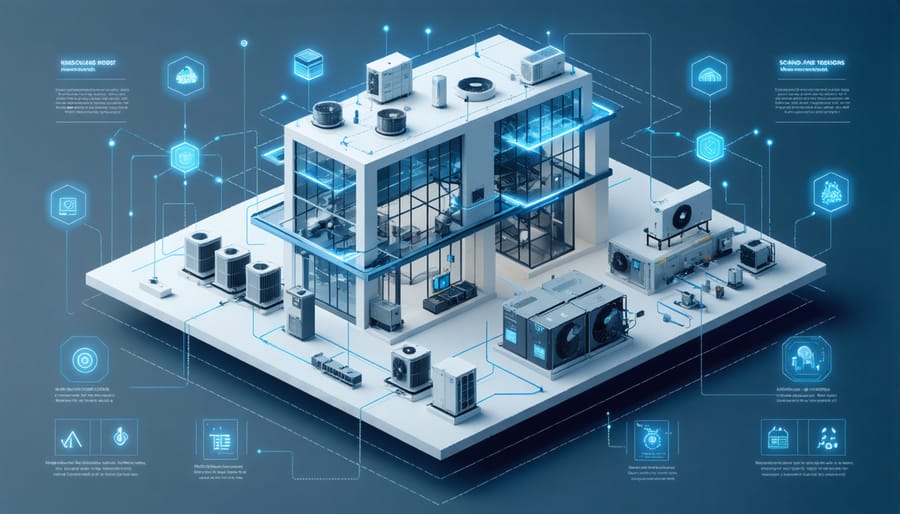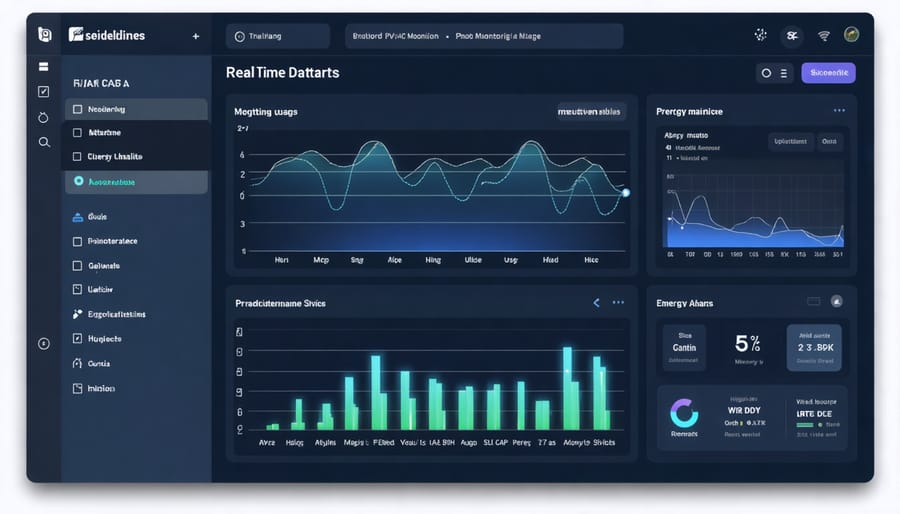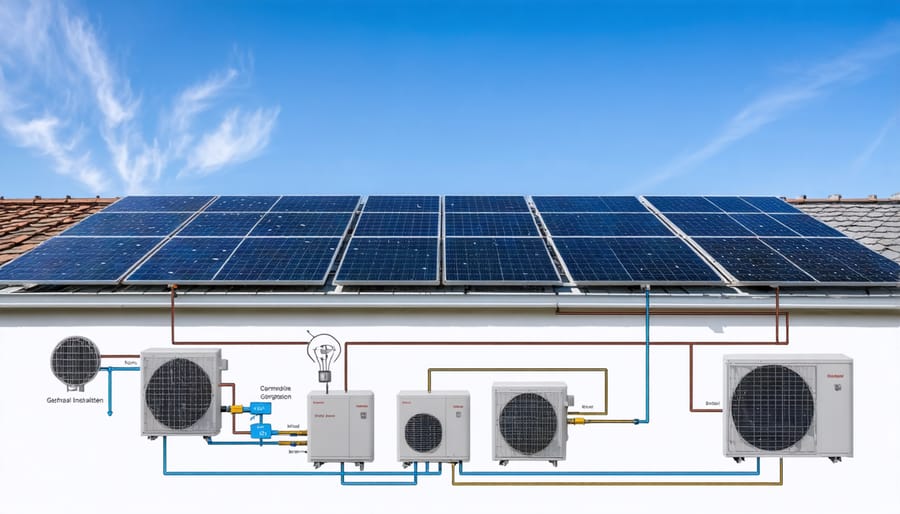Sustainable HVAC systems are revolutionizing how modern commercial buildings reduce energy costs while maintaining optimal comfort levels. Today’s innovative solutions combine smart sensors, renewable energy integration, and advanced automation to create efficient, environmentally responsible climate control systems that deliver impressive returns on investment.
Building owners and facility managers are discovering that sustainable HVAC technologies not only slash operational expenses by 30-50% but also significantly extend equipment lifespan and enhance occupant satisfaction. From variable refrigerant flow systems to geothermal heat pumps, these solutions represent the intersection of environmental responsibility and smart business practice.
By implementing sustainable HVAC strategies, commercial buildings can achieve both immediate cost savings and long-term environmental benefits. The integration of these systems isn’t just about being green – it’s about creating smarter, more efficient buildings that meet the demands of our changing climate while delivering measurable value to stakeholders.
This practical guide explores the latest sustainable HVAC technologies, their real-world applications, and the concrete steps facility managers can take to transform their building’s environmental impact and bottom line.
The Building Blocks of Sustainable HVAC

Energy-Efficient Equipment
Modern energy-efficient equipment is the backbone of sustainable HVAC systems in commercial buildings. High-efficiency chillers, for instance, use advanced compressor technology and smart controls to cool buildings while consuming up to 30% less energy than traditional models. These systems adapt their output based on real-time cooling demands, ensuring optimal performance without wasting energy.
Similarly, condensing boilers have revolutionized heating efficiency by capturing and using heat that would otherwise be lost through exhaust gases. These units can achieve efficiency ratings of up to 95%, compared to the 80-85% efficiency of conventional boilers. They’re particularly effective in moderate climates where they can operate in condensing mode more frequently.
Variable Air Volume (VAV) air handlers represent another significant advancement in HVAC technology. These sophisticated units adjust airflow based on actual needs rather than running at constant speeds. By incorporating EC (Electronically Commutated) motors and advanced controls, modern air handlers can reduce fan energy consumption by up to 50%.
When these components work together as an integrated system, they create a highly efficient HVAC solution that not only reduces energy costs but also improves indoor comfort and reduces environmental impact.
Smart Controls and Automation
Modern building automation systems are revolutionizing how commercial HVAC systems operate, making them smarter and more efficient than ever before. These intelligent controls use a network of sensors and smart devices to monitor everything from temperature and humidity to occupancy patterns and outdoor weather conditions.
Think of building automation as your building’s brain – it’s constantly collecting data and making real-time adjustments to ensure optimal comfort while minimizing energy waste. Sensors detect when specific areas are occupied and automatically adjust heating or cooling accordingly. When spaces are empty, the system scales back operation to save energy.
The Internet of Things (IoT) takes this automation even further by connecting all building systems to a central platform. Facility managers can monitor and control HVAC operations from their smartphones or tablets, receive instant alerts about potential issues, and access detailed performance reports to make data-driven decisions.
Smart scheduling features allow systems to learn from occupancy patterns and adjust automatically. For example, if a conference room is regularly used only on Monday mornings, the system will pre-condition that space just before it’s needed, rather than maintaining comfort conditions around the clock.
This level of intelligent control typically reduces energy consumption by 20-30%, while also extending equipment life through optimized operation.

Real-Time Monitoring and Predictive Maintenance
Sensor Networks
Modern sensor networks are the eyes and ears of sustainable HVAC systems, helping buildings operate more efficiently while maintaining optimal comfort. Temperature sensors placed strategically throughout the building monitor hot and cold spots, ensuring consistent climate control across different zones. These smart sensors can detect even minor fluctuations, allowing the system to make real-time adjustments.
Humidity sensors work alongside temperature monitors to maintain the perfect balance of moisture in the air. This is especially crucial in commercial spaces where maintaining proper humidity levels can affect both comfort and equipment longevity. Too much or too little humidity can lead to discomfort, energy waste, and even structural issues.
Perhaps the most game-changing addition to modern sensor networks is occupancy detection. These smart sensors can tell when spaces are being used and automatically adjust HVAC operations accordingly. For example, when a conference room is empty, the system can reduce conditioning to save energy. When people enter, it automatically returns to comfort settings. This responsive approach can lead to significant energy savings while ensuring occupant comfort is never compromised.
Together, these interconnected sensors create a dynamic system that responds to real-world conditions rather than following rigid schedules.
AI-Powered Analytics
In today’s commercial buildings, artificial intelligence is revolutionizing how HVAC systems operate, making them smarter and more efficient than ever before. These intelligent systems continuously analyze vast amounts of data from sensors throughout the building, learning patterns and optimizing performance in real-time.
AI algorithms can predict temperature fluctuations based on factors like occupancy patterns, weather forecasts, and historical data. This allows the system to make proactive adjustments, maintaining optimal comfort while minimizing energy usage. Advanced predictive maintenance systems can identify potential issues before they become problems, scheduling maintenance exactly when needed.
The real magic happens in how AI adapters learn from building usage patterns. For example, if a conference room is regularly used for meetings at specific times, the system will automatically adjust temperature settings to ensure comfort during those periods while conserving energy when the room is empty. This smart approach typically reduces energy consumption by 20-30% compared to traditional HVAC systems.
What’s particularly exciting is that these systems become more efficient over time as they gather more data and fine-tune their operations to your building’s specific needs.
Energy Recovery and Waste Reduction
Heat Recovery Systems
Heat recovery systems are game-changers in modern commercial HVAC, acting like smart recyclers for your building’s air and energy. These systems capture heat that would normally be lost through exhaust air and put it right back to work, significantly reducing energy waste and costs.
At the heart of these systems are two main players: Heat Exchange Ventilators (HEVs) and Energy Recovery Ventilators (ERVs). Think of HEVs as thermal bridges, transferring heat from outgoing stale air to incoming fresh air during winter, and reversing the process in summer. ERVs take this a step further by also managing moisture levels, making them particularly valuable in humid climates.
These systems work beautifully alongside other green technologies, including solar energy integration, to create a comprehensive energy-saving strategy. Building owners typically see a 40-80% reduction in ventilation energy costs, with most systems paying for themselves within 3-5 years through reduced energy bills.
By maintaining optimal indoor air quality while minimizing energy loss, heat recovery systems represent a smart investment in both comfort and sustainability.
Variable Load Management
Modern HVAC systems are getting smarter at handling the ever-changing demands of commercial buildings. Think of it as a conductor leading an orchestra – adjusting the performance based on what’s needed at any given moment. These intelligent systems use a network of sensors to monitor occupancy levels, outdoor temperatures, and indoor conditions in real-time.
When a conference room fills up with people, the system automatically increases airflow and cooling to maintain comfort. Similarly, during quiet periods or weekends when fewer people are present, it scales back operation to save energy. This responsive approach means no energy is wasted on heating or cooling empty spaces.
Weather-responsive controls take things a step further by anticipating and adapting to outdoor conditions. On a sunny winter day, the system might reduce heating in south-facing areas that benefit from natural warmth. During summer, it might pre-cool spaces before peak afternoon temperatures hit.
These smart adjustments not only keep occupants comfortable but can reduce energy consumption by 20-30% compared to traditional systems that run at constant levels regardless of actual needs.
Integration with Renewable Energy

Solar-Assisted Cooling
Solar-assisted cooling represents an innovative approach to reducing commercial buildings’ HVAC energy consumption. By harnessing solar power, these systems can significantly decrease operational costs while maintaining comfortable indoor temperatures. The process typically involves using solar thermal collectors to power absorption chillers, which create cooling effects without relying heavily on electricity.
What makes this technology particularly attractive is its peak performance coinciding with peak cooling demands – when the sun is strongest, these systems work their hardest. According to recent energy system cost analysis, buildings implementing solar-assisted cooling can reduce their cooling-related energy costs by 25-35%.
The system works by collecting solar energy through roof-mounted panels, which then powers the cooling cycle. This integration can be particularly effective when combined with traditional HVAC systems, creating a hybrid approach that ensures reliability while maximizing sustainability. Building managers can expect optimal performance during summer months, precisely when conventional cooling systems typically strain power grids the most.
While initial installation costs may be higher than traditional systems, the long-term benefits include reduced utility bills, lower maintenance costs, and decreased carbon emissions.
Geothermal Integration
Geothermal integration represents one of the most efficient ways to heat and cool commercial buildings while significantly reducing energy costs. Ground source heat pumps tap into the earth’s constant temperature, typically ranging from 50-60°F at depths of just a few feet, to provide reliable heating and cooling year-round.
The system works by circulating a fluid through underground pipes, called ground loops, which can be installed either vertically or horizontally depending on the available space. During winter, these loops extract heat from the ground to warm the building, while in summer, they transfer excess heat back into the earth to cool the space.
What makes geothermal particularly attractive for commercial buildings is its impressive efficiency – these systems can achieve 400-600% efficiency, meaning for every unit of electricity used, they provide 4-6 units of heating or cooling. This translates to substantial energy savings and reduced operating costs over time.
While initial installation costs are higher compared to conventional HVAC systems, the long-term benefits often justify the investment, with most systems paying for themselves within 5-10 years through reduced energy bills.
ROI and Environmental Impact
Financial Benefits
Investing in sustainable HVAC systems can lead to significant financial rewards for commercial building owners. Most buildings see a 20-30% reduction in energy costs within the first year of implementation, thanks to improved efficiency and smart controls. These systems typically pay for themselves within 3-5 years through reduced operational expenses.
The savings don’t stop at energy bills. Sustainable HVAC systems require less frequent maintenance and have longer lifespans than traditional units, cutting down on repair costs and replacement frequency. Smart monitoring systems can detect issues early, preventing costly emergency repairs and extending equipment life.
Many buildings report additional savings through utility rebates and tax incentives for green initiatives. When combined with reduced water consumption from efficient cooling towers and decreased demand charges during peak hours, the total financial benefits often exceed initial projections. Plus, buildings with sustainable HVAC systems typically command higher rental rates and maintain better occupancy levels, creating long-term value for property owners.
Environmental Advantages
Sustainable HVAC systems significantly reduce a building’s environmental impact, making them a crucial investment for eco-conscious businesses. These systems typically cut carbon emissions by 30-50% compared to traditional HVAC setups, primarily through improved energy efficiency and smarter resource use.
Modern sustainable HVAC solutions help buildings achieve important green certifications like LEED and ENERGY STAR, boosting their environmental credentials. The systems often integrate renewable energy sources, such as solar thermal and geothermal power, further reducing reliance on fossil fuels.
Beyond energy savings, these systems use environmentally friendly refrigerants with lower global warming potential. They also optimize air quality and ventilation, reducing waste and improving the overall ecological footprint of commercial buildings. Many sustainable HVAC installations include smart monitoring systems that track and report environmental performance metrics, helping businesses meet their sustainability goals and comply with increasingly strict environmental regulations.
Embracing sustainable HVAC solutions in commercial buildings isn’t just good for the environment – it’s a smart business decision that pays dividends in multiple ways. From reduced energy costs and improved indoor air quality to enhanced tenant satisfaction and increased property value, the benefits are clear and compelling. By implementing energy-efficient technologies, smart controls, and regular maintenance practices, building owners can significantly reduce their carbon footprint while enjoying substantial operational savings. As we move toward a more sustainable future, the adoption of green HVAC systems is becoming less of an option and more of a necessity. Start your sustainability journey today by exploring these solutions, and join the growing number of forward-thinking businesses that are making a positive impact on both their bottom line and the planet.
